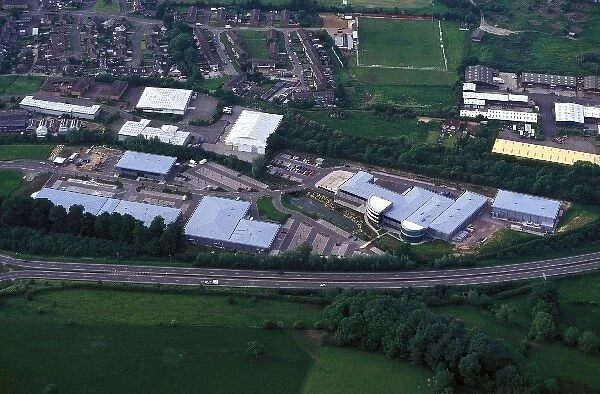When British American Tobacco wanted to increase their involvement in Formula One, they decided the best way to do this was by buying the Ken Tyrrell's small team of former world champions based in Ockham, Surrey. By this point in time Ken Tyrrell was an old man who was looking to retire and his team long past their best. He sold the outfit bearing his name during the 1998 season to the American tobacco giant and the new team made their debut for the start of the 1999 season under the stewardship of manager Craig Pollock. After years of under funding, the newly rechristened British American Racing team were going to need investment on a large scale to make them a force to be reckoned with once more.
 |
| Tyrrell's obsolete HQ at Ockham, Surrey. |
Between their debut year of 1999 and 2001 Reynard produced the team's cars at it's Brackley facility in Northamptonshire. After Reynard's demise over the winter of 2001, BAR bought their factory from the receivers and it has since been the base for all the various different incarnations of the team to the present day.
 |
| An overhead shot of the former Reynard HQ at Brackley, Northamptonshire. |
Powered by Honda from the year 2000 onwards BAR's peak year in Formula One was the 2004 season, suprisingly finishing second in the constructors championship despite not winning a race. A large part of this success was based on the Honda RA004E engine, which by the end of that season was almost at the magical 1000 bhp barrier and believed to be the most powerful engine in the field. With this successful engine program and a disastrous 2005 season for BAR that failed to live up to the promise of the year before, Honda bought the whole team from British American Tobacco for the start of the 2006 season.
A maiden victory for both Honda and Button at the 2006 Hungarian GP was scant return for the investment made on the Japanese manufacturer's part and the team's campaigns between 2006 and 2008 can only be described as abject. This combined with the economic downturn of 2008 and 2009 saw Honda withdraw from the sport completely and suddenly during the winter of 2008.
 |
| The woeful Honda RA108 from the 2008 season. |
The team and some of it's personnel were saved by a management buyout organised by Nick Fry and Ross Brawn. Unbelievably given the circumstances and the team's form in it's previous guise as Honda, the newly christened "Brawn GP" won the 2009 driver's world championship for Jenson Button. This success was largely built on a clever interpretation of the rules by an employee of the former Honda spin off team Super Aguri to produce what was known at the time as a "double diffuser".
This gave the team much more downforce than the other teams who had not interpreted the rules in this way and during the first half of the 2009 season Brawn GP were the class of the field. However, due to the large number of redundancies the team had been forced to make as result of Honda's withdrawal they were not able to maintain the level of performance of rival teams and the second half of the season saw them fall back behind the likes of Red Bull and Mclaren. They only just clinched the title at the final round in Brazil after a great drive from 14th on the grid by Jenson Button.
 |
| A drawing of the controversial Brawn GP "double diffuser". |
At the end of the 2009 season Brawn GP was purchased outright by it's engine supplier Mercedes (who had stepped in at the last minute to help save the team at the beginning of the year) and became their full works team. A combination of staff culls while still Brawn GP and Mercedes initially not being prepared to match the budgets of the likes of Red Bull, Ferrari and Mclaren have meant that Mercedes have struggled to become championship contenders, despite the return to the sport of seven time world champion Michael Schumacher to drive for them.
After the team's first win (and also the first for driver Nico Rosberg) during the 2012 season, their early season form fell away and by the end of the year Mercedes were struggling even to score points. For 2013, after a period where Mercedes considered leaving the sport altogether and throwing the futures of those who work at it's Brackley base into doubt once more, the Stuttgart based manufacturer has committed to the sport for a further period, increasing the race team's overall budget and signing 2008 world champion Lewis Hamilton from Mclaren.
 |
| The Mercedes F1 program has been held back by budget restraints and staff cuts during the Brawn GP era. |
The 2013 season period may be one of consolidation and incremental progress for the team with 2014 representing their best chance to challenge for the title, with sweeping changes coming into the sport that will favour teams who manufacture their own engines. Only time will tell if the the organisation that has it's roots in the old Reynard F1 project can finally deliver long term success after all the money that has been invested in it.

No comments:
Post a Comment